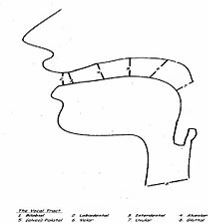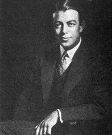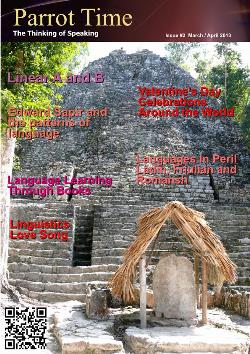Edward Sapir
Patterns of Language

|
IALA Sapir was active in the international auxiliary language movement which pushed to create a constructed language that could be used by people all over the world instead of learning each others languages. He published " The Function of an International Auxiliary Language" in which he spoke of the benefits of a regular grammar and pushed for a critical focus on the fundamentals of language without the bias of national language idiosyncrasies while selecting an international auxiliary language. He was also the first Research Director of the International Auxiliary Language Association (IALA). It was a position he held between 1930 and 1931. Added to all this, he was a member of IALA's Consultative Counsel for Linguistic Research from 1927 to 1938 and consulted with Alice Vanderbilt Morris to develop the research program of IALA. Phonology Sapir made a major contribution to linguistic theory with his work in phonology (the study of sound systems). He published his paper "Sound Patterns in Language" in 1925 in the first issue of "Language", the journal of the Linguistic Society of America of which Sapir was a founder. In this, he defined his concept of a phoneme, viewing it in terms of its relationships among sounds rather than its objective qualities. This addressed phonemes as a psychological phenomena and not just the commonly accepted physical aspects. Why this is of importance is that it raises phonemes from being single individual entities to being influenced by other phonemes, not just in one language but across related languages. By looking at these connections, one can see a larger pattern between languages. He continued this pattern argument in 1933 with his paper "The Psychological Reality of the Phoneme" in which he discussed how the the systematic and conventional nature of sounds is understood at an intuitive level by native speakers. 
With these two papers, Sapir had laid the groundwork for much that would come in the field of phonemics (the study of conventionally relevant sounds). This new way of viewing phonology helped revolutionize American linguistics. It was derived from Sapir's extensive fieldwork with the American Indian languages, yet paralleled the work being done in Europe on phonomic models by linguistics that were working from the influence of the Swiss linguist Ferdinand de Saussure. Grammar Another area of Sapir's work involved carrying on and expanding on the ideas of his one time teacher, Franz Boas, who applied a very scientific method to the study of linguistics and criticized heavily the previous work of fellow anthropologists. In 1916, Sapir published "Time Perspective in Aboriginal American Culture: A Study in Method" in which he put forth the methods used by Boas to examine the historical connections between culture and language. He also included linguistics examples from a wide range of cases. Essentially, as a culture develops, traces of the past are maintained in the language, so languages played a key role in understanding not just the current culture but how it evolved. Since these changes came through the spoken language, they were usable in the absence of a written language. Furthermore, since the language sounds were traceable across related languages, a connection could be made between different peoples over time. Languages could be used to assist in showing genetic relationships. Sapir published the only book he completed in his lifetime, "Language: An Introduction to the Study of Speech", in 1921. It was aimed at a more general audience and talked about the precision and beauty of grammar of both written and non-written languages and was so visionary in its views that is still influences modern linguists. The way a person expresses themselves shapes their culture, even if they don’t realize this is happening. Sapir-Whorf Hypothesis Sapir published "The Unconscious Patterning of Behavior in Society" in 1927. Combining both of his concepts of phonology and grammar, Sapir formulated that culture should be viewed as part of individually learned patterns, both conscious and unconscious and not as external elements. If culture comes from learned rules of the society instead of as fixed structure, and language plays a key role in thought and communications, then culture and language are distinctly tied together. The way a person expresses themselves shapes their culture, even if they don't realize this is happening. His 1929 paper "The Status of Linguistics as a Science" furthered these ideas. Because of a language's central place in a culture, it works as a "guide to 'social reality"' and largely shapes an individual's and a culture's perception of the world. Since language can be subjected to a systematic analysis, it can also be an essential tool for understanding a culture, even it's most elusive aspects. 
Benjamin Lee Whorf These theories became his contribution to a larger theory, the Sapir-Whorf hypothesis. One of Sapir's students, Benjamin Lee Whorf, wrote more along this same theory after Sapir's death, publishing his own observations on how linguistic differences have consequences in human cognition and behavior. Harry Hoijer, another of Sapir's students, actually created the term "Sapir–Whorf hypothesis", even though Sapir and Whorf never put forth any such hypothesis or even worked together to formulate the ideas apart from the teacher-student relationship. Yet this has become what most people know of Sapir. Sapir contributed to almost every important topic in linguistics and while some of his works no longer receive as much attention, like that on the construction of an international language, his influence on linguistics and related fields can still be strongly felt today. He also produced an extremely large volume of work during his lifetime and his many themes are still discussed by modern students of linguistics. | ||
|
PARTIAL LIST OF WORKS
| ||
| Edward Sapir - Patterns of Language | ||||||||||||||
| Writer: | Sofia Ozols | |||||||||||||
| Images: | ||||||||||||||
| ||||||||||||||
| Sources: | ||||||||||||||
| ||||||||||||||
All images are Copyright - CC BY-SA (Creative Commons Share Alike) by their respective owners, except for Petey, which is Public Domain (PD) or unless otherwise noted.
comments powered by Disqus



















